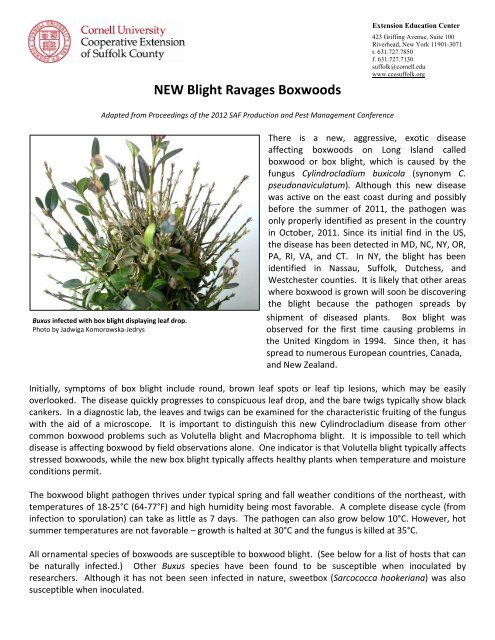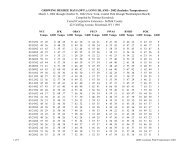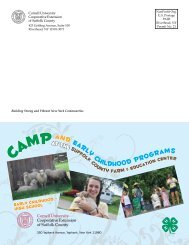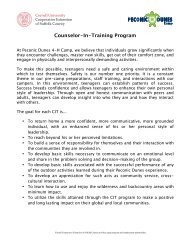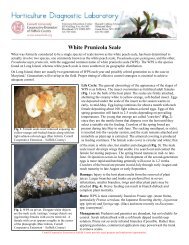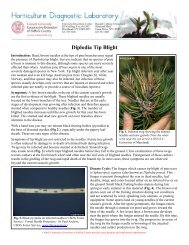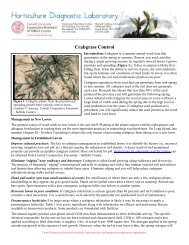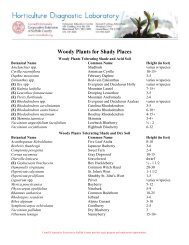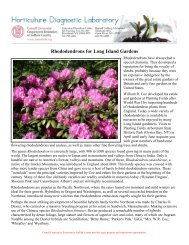NEW Blight Ravages Boxwoods - Cornell Cooperative Extension of ...
NEW Blight Ravages Boxwoods - Cornell Cooperative Extension of ...
NEW Blight Ravages Boxwoods - Cornell Cooperative Extension of ...
You also want an ePaper? Increase the reach of your titles
YUMPU automatically turns print PDFs into web optimized ePapers that Google loves.
<strong>NEW</strong> <strong>Blight</strong> <strong>Ravages</strong> <strong>Boxwoods</strong><br />
Adapted from Proceedings <strong>of</strong> the 2012 SAF Production and Pest Management Conference<br />
Buxus infected with box blight displaying leaf drop.<br />
Photo by Jadwiga Komorowska-Jedrys<br />
<strong>Extension</strong> Education Center<br />
423 Griffing Avenue, Suite 100<br />
Riverhead, New York 11901-3071<br />
t. 631.727.7850<br />
f. 631.727.7130<br />
suffolk@cornell.edu<br />
www.ccesuffolk.org<br />
There is a new, aggressive, exotic disease<br />
affecting boxwoods on Long Island called<br />
boxwood or box blight, which is caused by the<br />
fungus Cylindrocladium buxicola (synonym C.<br />
pseudonaviculatum). Although this new disease<br />
was active on the east coast during and possibly<br />
before the summer <strong>of</strong> 2011, the pathogen was<br />
only properly identified as present in the country<br />
in October, 2011. Since its initial find in the US,<br />
the disease has been detected in MD, NC, NY, OR,<br />
PA, RI, VA, and CT. In NY, the blight has been<br />
identified in Nassau, Suffolk, Dutchess, and<br />
Westchester counties. It is likely that other areas<br />
where boxwood is grown will soon be discovering<br />
the blight because the pathogen spreads by<br />
shipment <strong>of</strong> diseased plants. Box blight was<br />
observed for the first time causing problems in<br />
the United Kingdom in 1994. Since then, it has<br />
spread to numerous European countries, Canada,<br />
and New Zealand.<br />
Initially, symptoms <strong>of</strong> box blight include round, brown leaf spots or leaf tip lesions, which may be easily<br />
overlooked. The disease quickly progresses to conspicuous leaf drop, and the bare twigs typically show black<br />
cankers. In a diagnostic lab, the leaves and twigs can be examined for the characteristic fruiting <strong>of</strong> the fungus<br />
with the aid <strong>of</strong> a microscope. It is important to distinguish this new Cylindrocladium disease from other<br />
common boxwood problems such as Volutella blight and Macrophoma blight. It is impossible to tell which<br />
disease is affecting boxwood by field observations alone. One indicator is that Volutella blight typically affects<br />
stressed boxwoods, while the new box blight typically affects healthy plants when temperature and moisture<br />
conditions permit.<br />
The boxwood blight pathogen thrives under typical spring and fall weather conditions <strong>of</strong> the northeast, with<br />
temperatures <strong>of</strong> 18-25°C (64-77°F) and high humidity being most favorable. A complete disease cycle (from<br />
infection to sporulation) can take as little as 7 days. The pathogen can also grow below 10°C. However, hot<br />
summer temperatures are not favorable – growth is halted at 30°C and the fungus is killed at 35°C.<br />
All ornamental species <strong>of</strong> boxwoods are susceptible to boxwood blight. (See below for a list <strong>of</strong> hosts that can<br />
be naturally infected.) Other Buxus species have been found to be susceptible when inoculated by<br />
researchers. Although it has not been seen infected in nature, sweetbox (Sarcococca hookeriana) was also<br />
susceptible when inoculated.
Some Hosts <strong>of</strong> Cylindrocladium buxicola (natural infection observed) 1<br />
Common (American) boxwood:<br />
B. sempervirens<br />
B. sempervirens ‘Angustifolia’<br />
B. sempervirens ‘Arctic Emerald’<br />
B. sempervirens ‘Blauer Heinz’<br />
B. sempervirens ‘Compacta’<br />
B. sempervirens ’Elegantissima’<br />
B. sempervirens ‘Graham Blandy’<br />
B. sempervirens ‘Jade Pillar’<br />
B. sempervirens ‘Latifolia Maculata’<br />
B. sempervirens ‘Memorial’<br />
B. sempervirens ‘Variegata’<br />
English boxwood:<br />
B. sempervirens ‘Suffruticosa’<br />
B. sempervirens ‘Suffruticosa variegata’<br />
Korean boxwood:<br />
B. sinica var. insularis ‘Justin Brouwers’<br />
B. sinica var. insularis ‘Winter Gem’<br />
B. sinica var. insularis ‘Winter Green’<br />
Hybrids:<br />
B. sinica var. insularis X B. sempervirens hybrid ‘Green Mountain’<br />
B. sinica var. insularis X B. sempervirens hybrid ‘Green Gem’<br />
B. sinica var. insularis X B. sempervirens hybrid ‘Green Velvet’<br />
B. sinica var. insularis X B. sempervirens hybrid ‘Chicagoland’<br />
B. sinica var. insularis X B. sempervirens hybrid ‘Green Ice’<br />
B. sinica var. insularis X B. sempervirens hybrid ‘Big Leaf Gordo’<br />
Littleleaf boxwood:<br />
B. microphylla ‘Faulkner’<br />
B. microphylla var. Japonica ‘Morris Midget’<br />
B. microphylla var. japonica ‘National’<br />
B. microphylla var. japonica ‘North Star’<br />
B. microphylla var. japonica ‘Green Beauty’<br />
B. microphylla var. japonica ‘Baby Gem’<br />
1 Sources: Douglas, S. M. 2011. Boxwood blight—a new disease for Connecticut and the U. S.<br />
http://www.ct.gov/caes/lib/caes/documents/publications/fact_sheets/plant_pathology_and_ecology/boxwood_blight-<br />
_a_new_disease_for_connecticut_and_the_u.s.__12-08-11.pdf<br />
Henricot, B. 2006. Box blight rampages onward. The Plantsman 5:153‐157.<br />
<strong>Extension</strong> Education Center<br />
423 Griffing Avenue, Suite 100<br />
Riverhead, New York 11901-3071<br />
t. 631.727.7850<br />
f. 631.727.7130<br />
suffolk@cornell.edu<br />
www.ccesuffolk.org<br />
Box <strong>Blight</strong> can produce leaf spots, leaf drop, and black cankers on<br />
Buxus twigs. Photo by Jadwiga Komorowska-Jedrys<br />
It is difficult to predict the exact impact <strong>of</strong> this new boxwood disease, but European experience makes it clear<br />
that both gardeners and the horticulture industry need to take this disease very seriously in order to prevent it<br />
from becoming a common, established problem everywhere boxwood is grown. <strong>Boxwoods</strong>, highly valued<br />
here on Long Island for their deer resistance and evergreen nature, could easily change from a ubiquitous<br />
landscape ornamental to a rare, unsustainable plant.<br />
Accurate identification followed by prompt action can help slow the spread <strong>of</strong> this serious disease. Any<br />
horticultural business or homeowner with boxwoods currently on their property should search for symptoms
<strong>Extension</strong> Education Center<br />
423 Griffing Avenue, Suite 100<br />
Riverhead, New York 11901-3071<br />
t. 631.727.7850<br />
f. 631.727.7130<br />
suffolk@cornell.edu<br />
www.ccesuffolk.org<br />
immediately. If you see large areas <strong>of</strong> bare twigs on any species <strong>of</strong> boxwood this winter (in the nursery,<br />
landscape, or garden center), or dramatic leaf spotting, defoliation, and dieback during the growing season,<br />
send in a sample for laboratory identification. Commercial samples should be sent to the LI Horticultural<br />
Research & <strong>Extension</strong> Center at 3059 Sound Ave, Riverhead, NY 11901 / 631‐727‐3595. Non‐commercial,<br />
homeowner samples should be sent to the CCE <strong>of</strong> Suffolk County Diagnostic Lab at 423 Griffing Ave,<br />
Riverhead, NY 11901 / 631‐727‐4126.<br />
If a positive identification <strong>of</strong> boxwood blight is made, diseased plants and all plant debris must be removed as<br />
thoroughly and quickly as possible. Currently, this new species <strong>of</strong> Cylindrocladium will not be able to be<br />
controlled with fungicides. Masking the problem with fungicides rather than taking more strict eradication<br />
actions would be a mistake – the disease will then become extensively distributed. Sanitation efforts after a<br />
disease outbreak must be extremely thorough — after bagging and removing diseased plants, any leaves left<br />
behind must be gathered, removed, and burned or buried. Vacuuming may be a good option for hardscape<br />
and in the nursery. Because the pathogen can survive in fallen leaves for up to 5 years, composting is not an<br />
option. All boxwoods and boxwood leaf debris remaining in a garden center or landscape this winter should<br />
be destroyed if this disease is found, and if new boxwoods are introduced, they should be placed as far as<br />
possible from where boxwoods were set in 2011.<br />
In the future, the horticulture industry will probably find it desirable to produce alternate evergreen<br />
ornamentals. Valuable historic gardens would be wise to not introduce any Buxus plants for the foreseeable<br />
future, in order to avoid introducing this fungus.<br />
For More Information<br />
• Bulletin from Connecticut Agricultural Experiment Station by Sharon Douglashttp://www.ct.gov/caes/lib/caes/documents/publications/fact_sheets/plant_pathology_and_ecology/boxwood_blight-<br />
_a_new_disease_for_connecticut_and_the_u.s.__12-08-11.pdf<br />
• A webinar presented by Kelly Ivors at NC State University on January 5, 2012 is available athttp://go.ncsu.edu/box_blight_webinar<br />
• An excellent North Carolina fact sheet is available by Googling “NC Pest Alert box blight.”<br />
• Henricot, B. 2006. Box blight rampages onwards. The Plantsman 5:153‐157.<br />
This publication was created by Margery Daughtrey, Plant Pathologist, <strong>Cornell</strong> University and<br />
Alexis Alvey, Nursery & Landscape Specialist, <strong>Cornell</strong> <strong>Cooperative</strong> <strong>Extension</strong> <strong>of</strong> Suffolk County<br />
January 2012 (updated February 2012)<br />
<strong>Cornell</strong> <strong>Cooperative</strong> <strong>Extension</strong> <strong>of</strong> Suffolk County provides equal program and employment opportunities.<br />
Please contact the <strong>Cornell</strong> <strong>Cooperative</strong> <strong>Extension</strong> <strong>of</strong> Suffolk County <strong>of</strong>fice if you have any special needs.<br />
<strong>Cornell</strong> <strong>Cooperative</strong> <strong>Extension</strong> is funded in part by Suffolk County through the <strong>of</strong>fice <strong>of</strong> the County Executive and the County Legislature.


